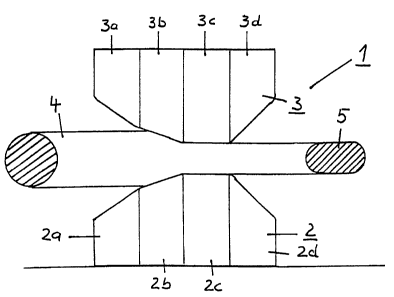Une partie des informations de ce site Web a été fournie par des sources externes. Le gouvernement du Canada n'assume aucune responsabilité concernant la précision, l'actualité ou la fiabilité des informations fournies par les sources externes. Les utilisateurs qui désirent employer cette information devraient consulter directement la source des informations. Le contenu fourni par les sources externes n'est pas assujetti aux exigences sur les langues officielles, la protection des renseignements personnels et l'accessibilité.
L'apparition de différences dans le texte et l'image des Revendications et de l'Abrégé dépend du moment auquel le document est publié. Les textes des Revendications et de l'Abrégé sont affichés :
| (12) Brevet: | (11) CA 2436755 |
|---|---|
| (54) Titre français: | METHODE DE PRODUCTION CONTINUE DE FILS METALLIQUES |
| (54) Titre anglais: | METHOD OF CONTINUOUS PRODUCTION OF METAL WIRES |
| Statut: | Réputé périmé |
| (51) Classification internationale des brevets (CIB): |
|
|---|---|
| (72) Inventeurs : |
|
| (73) Titulaires : |
|
| (71) Demandeurs : |
|
| (74) Agent: | ROBIC |
| (74) Co-agent: | |
| (45) Délivré: | 2009-08-04 |
| (22) Date de dépôt: | 2003-08-07 |
| (41) Mise à la disponibilité du public: | 2004-02-13 |
| Requête d'examen: | 2006-05-16 |
| Licence disponible: | S.O. |
| (25) Langue des documents déposés: | Anglais |
| Traité de coopération en matière de brevets (PCT): | Non |
|---|
| (30) Données de priorité de la demande: | ||||||
|---|---|---|---|---|---|---|
|
Dans une méthode de production en continu de fils de métal, la section transversale d'un fil de métal rond est réduite en une ou plusieurs étapes. Pour ce faire, le fil de métal est formé dans un trou ouvert d'un côté pour former un fil plat au moins à la dernière étape.
In a method for continuous production of metal wires, the cross section of a round metal wire is reduced in one or more stages. To do so, the metal wire is shaped in a bore that is open on one side to form a flat wire at least in the last stage.
Note : Les revendications sont présentées dans la langue officielle dans laquelle elles ont été soumises.
Note : Les descriptions sont présentées dans la langue officielle dans laquelle elles ont été soumises.

Pour une meilleure compréhension de l'état de la demande ou brevet qui figure sur cette page, la rubrique Mise en garde , et les descriptions de Brevet , États administratifs , Taxes périodiques et Historique des paiements devraient être consultées.
| Titre | Date |
|---|---|
| Date de délivrance prévu | 2009-08-04 |
| (22) Dépôt | 2003-08-07 |
| (41) Mise à la disponibilité du public | 2004-02-13 |
| Requête d'examen | 2006-05-16 |
| (45) Délivré | 2009-08-04 |
| Réputé périmé | 2012-08-07 |
Il n'y a pas d'historique d'abandonnement
| Type de taxes | Anniversaire | Échéance | Montant payé | Date payée |
|---|---|---|---|---|
| Le dépôt d'une demande de brevet | 300,00 $ | 2003-08-07 | ||
| Enregistrement de documents | 100,00 $ | 2003-10-17 | ||
| Taxe de maintien en état - Demande - nouvelle loi | 2 | 2005-08-08 | 100,00 $ | 2005-07-26 |
| Requête d'examen | 800,00 $ | 2006-05-16 | ||
| Taxe de maintien en état - Demande - nouvelle loi | 3 | 2006-08-07 | 100,00 $ | 2006-07-21 |
| Taxe de maintien en état - Demande - nouvelle loi | 4 | 2007-08-07 | 100,00 $ | 2007-07-25 |
| Taxe de maintien en état - Demande - nouvelle loi | 5 | 2008-08-07 | 200,00 $ | 2008-07-24 |
| Taxe finale | 300,00 $ | 2009-05-14 | ||
| Taxe de maintien en état - brevet - nouvelle loi | 6 | 2009-08-07 | 200,00 $ | 2009-07-27 |
| Taxe de maintien en état - brevet - nouvelle loi | 7 | 2010-08-09 | 200,00 $ | 2010-07-23 |
Les titulaires actuels et antérieures au dossier sont affichés en ordre alphabétique.
| Titulaires actuels au dossier |
|---|
| NEXANS |
| Titulaires antérieures au dossier |
|---|
| LOTTNER, GUENTER |